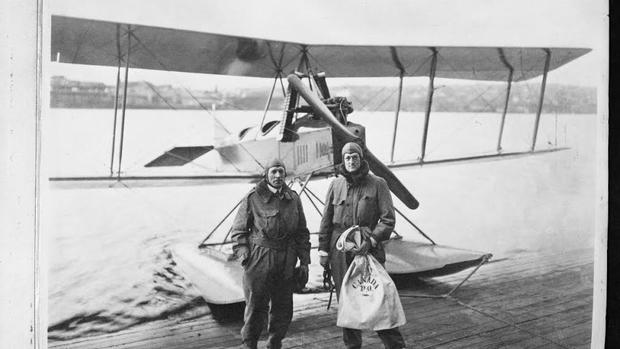Boeing: 100 years of transforming global travel
Boeing is the only company in the U.S. that builds jumbo jets, and soon, it will soar past a milestone. Boeing began with a canvas and wood airplane nearly 100 years ago. That first biplane led to today's 787 Dreamliner. Over a century, Boeing transformed travel across the globe.
The story of Boeing is in many ways the story of America and what American ingenuity can accomplish, reports CBS News correspondent Jan Crawford.
In a world where flying is routine but gravity is a law of nature, it's still mind-blowing: 500,000 pounds rising into the sky, miles above the earth, soaring at 35,000 feet. Nearly four million people fly on a Boeing-made jet each day, and last year, Boeing delivered more than 700 airplanes.
A factory outside Seattle is where it all comes together.
"Do you ever just walk in here and go, 'Wow'?" Crawford asked.
"Literally, no lie, every day," Boeing Vice President Elizabeth Lund said.
These are among the biggest airplanes in the world, built by Boeing in one of the world's biggest buildings and overseen by Lund.
"If you took the Empire State Building and you laid it on its side you could put 12 of them fully inside the building that we're in right now," Lund said.
You need that much space when on any given day you're building more than 20 jumbo jets at a time.
From start to finish, it takes just five weeks to manufacture the airplane. They're assembled with some automation, but at its core are people - 40,000 Boeing employees at this one site -- rolling out a product that will take millions of people around the world.
"It is like the story of America, right? You think of the progress made by the world... led by American ingenuity, and Boeing is just, I think, we are a leader in that effort," Lund said.
Bill Boeing started the company 100 years ago with a pontoon seaplane.
Before long, Boeing planes were everywhere, supporting America at war and ushering in a new age of travel, and even helping get us to the moon.
Today it's the biggest aerospace company in the world.
In the world of aviation, everyone knows the name Joe Sutter. Fifty years ago, he led a revolution in air travel, designing the iconic 747.
Skeptics said a jet that big would never work. But Sutter was proven right from the 747's first flight.
The landing was perfect.
"When I went out to the runway, I hugged (my wife) Nancy. She was crying," Sutter said.
"Your wife was crying? Because she was so relieved?" Crawford asked him.
"Relieved, yeah, and happy for the fact that what I told her was the truth," he said.
Sutter has been with Boeing for nearly 70 years and says the work is personal.
"If I hear on the news that an airplane got into trouble, I still say to myself, 'I wonder if it's a Boeing airplane and I wonder if there's something I did wrong.' It's something you never leave behind you," Sutter said.
Talking with people at Boeing, you hear that over and over, from the guys on the line to CEO Dennis Muilenburg.
"We know we work on things that really matter, and people's lives literally depend on what we do,"Muilenburg said.
There have been stumbles. Muilenburg said perhaps the biggest was the highly-anticipated Dreamliner.
Boeing developed entirely new technology to make it more comfortable and fuel-efficient, but manufacturing delays put the airplane behind schedule, and then there was a problem with overheating batteries.
A fire started on one flight and another had to make an emergency landing. No one was hurt, but the plane was grounded.
"When we are unable to deliver on our commitment, at some point it's devastating, it's discouraging. That's just not who we are," Lund said.
Boeing redesigned the battery and now the Dreamliner is back in the sky. From the setback, Boeing learned the perils of changing too much too fast.
That's why they're taking existing technology and tweaking it for new products, like folding wingtips on Boeing-made fighter jets. That innovation will go on Boeing's next big passenger plane so it can fit at more airport gates.
"We've got to be on the forefront and the leading edge of innovation or we're going to get passed by," Lund said.
"We see more competitors around the world," Muilenburg said.
It's only real competitor now is the European consortium Airbus. The companies are locked in a fierce head-to-head battle in a worldwide market.
Today Boeing sells more than 70 percent of its airplanes outside the U.S.
And when it looks to the next 100 years, it sees even more growth overseas, especially in China.
"Our projection is that the world over the next 20 years needs 38,000 new commercial airplanes," Muilenburg said.
More than 6,000 of those will be in China, he said.
"Many people don't realize it, but we're the U.S.'s biggest exporter in the manufacturing sector. So aerospace, airplanes -- it's a global business," Muilenburg said.
As a further example of the relationship between Boeing and China, when the Chinese President Xi Jinping came to the U.S. in September, he went to the factory outside Seattle, and Boeing announced it is building a plant in China.
Donald Trump said that will cost American jobs, but Boeing said it's solidifying its relationship with China -- and that will only increase airline orders and jobs in the U.S.
